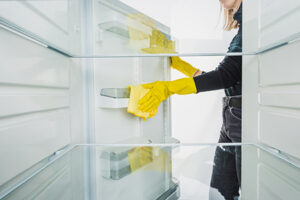PGS News
How to Clean Your Commercial Refrigerator
Routinely cleaning your commercial fridge is the best way to prevent bacteria growth and spoiled food. When you avoid cleaning your commercial refrigerator, your appliance works harder to keep food and beverages cold or frozen.
An overworking appliance increases your energy bill and shortens the lifespan of your refrigerator.
It’s expensive to constantly replace commercial refrigerators, so the best way to avoid this additional expense is to clean them regularly.
Five Steps for Commercial Refrigerator Maintenance
The cleanest refrigerators come from a systemized cleaning schedule. Follow these five steps to save food and money.
Step 1: Remove All Food
Commercial refrigerator cleaning requires emptying the entire refrigerator. Although you can easily go on autopilot mode while removing food, pay attention to expiration dates for food safety.

If something is expired, remove it. Expired food spoils fresh food faster.
Step 2: Unplug the Appliance
After you’ve removed all food from the cooler, unplug the appliance. Since the unit is empty, it doesn’t need to keep anything cool. Additionally, unplugging the unit helps you maneuver the unit to clean everywhere.
Step 3: Deep Clean the Interior and Exterior
Now comes the most arduous part of the process–cleaning the interior and exterior.
To clean the interior of the fridge, you’ll want to use soapy water. You can use a sponge or microfiber towel to wipe down the shelves. Be sure to scrub and get in all the corners. Throughout the cleaning process, you’ll need to remove shelves to clean every nook and cranny.

Once you’ve scrubbed down the interior, wipe down the exterior of the refrigerator or freezer. Dust and germs from customers spread easily on handles. windows, and door gaskets.
Step 4: Clean Coils and Pans
When cleaning the back of your unit, pay close attention to the condenser coil, evaporator coil, drain lines, and drain pan. Dust easily builds up over these parts, which increases your unit’s internal temperature and can lead to overworking.
Step 5: Return the Food to the Unit
After you’ve cleaned and used a food-safe sanitizer to disinfect your refrigeration units, turn your unit back on to start cooling the warm air. Give your refrigerator a couple of minutes to get the temperature down in the unit before returning the food. As you return the food, double-check expired food products and get rid of them.
Conclusion
Routine cleaning of your commercial refrigerator on a regular basis is essential for running your business. Whether you use the refrigerator to sell drinks at a restaurant or store aisles worth of food in a grocery store, a commercial refrigerator is necessary.
Cleaning your fridge will help the food last longer, prevent the spread of germs and disease, and save you money on energy costs.
